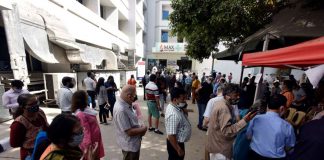SEPTEMBER 3, 2022

Rep. G.K. Butterfield was proud to be in Congress. Some years ago, the veteran Democrat installed a vanity message on his congressional license plate, broadcasting the district he represents: North Carolina 1.
Those days are over.
In recent years, the number of menacing threats against sitting members of Congress has ballooned, forcing the Capitol Police to launch thousands of investigations; prompting a flood of new funding for lawmaker security back home and in Washington; and impelling lawmakers to take remarkable precautions to ensure they don’t become the next target of political violence.
For Butterfield, that meant taking steps to become more anonymous when he’s out in public.
“I’ve taken the congressional license tags off of my car, because I don’t want to be identified publicly. It was right after Jan. 6,” Butterfield said before the House left Washington for the long summer recess.
“I used to be proud to display the plate, had No. 1 on my plate for the 1st District — North Carolina 1,” he continued. “Used to be a time when people would pull up beside me at the stoplight and give me the thumbs up. But now it’s different.”
The source of the concern is not merely anecdotal. Over the past half-decade, the number of threat investigations launched by the U.S. Capitol Police has skyrocketed, from 3,939 in 2017 to 9,625 in 2021 — a spike of almost 150 percent, according to numbers provided by the department.
As members of Congress head into a long Labor Day weekend of parades, barbecues and other district events — a holiday marking the unofficial launch of the final leg of public campaigning ahead of November’s midterm elections — they seem to be keenly leery of what they might encounter.
“The threat level has been elevated,” Rep. Jamie Raskin (D-Md.), a member of the select committee investigating last year’s attack on the U.S. Capitol, said Friday. “There has been a coarsening of discourse, and a perceived relaxation in inhibitions people would have about attacking public officials.”
Raskin spoke Friday while flanked by a security detail matching those assigned to each member of the Jan. 6 investigative panel.
The spike in lawmaker threats has coincided with increasingly personal and bitter attack lines stemming from the Trump era, with Democrats maintaining that the blame falls squarely on the former president and his fiery rhetoric against perceived political enemies.
“We hear — you’ve heard it — more and more talk about violence as an acceptable political tool in this country. It’s not. It can never be an acceptable tool,” President Biden said Thursday night in Philadelphia, where he castigated Trump and those who do not condemn violence as “a threat to democracy.”
“We can’t be pro-insurrectionist and pro-American. They’re incompatible,” Biden added.
Trump’s supporters have rushed to his defense, saying accusations that the former president encourages violence are merely political attacks designed to hurt his chances of returning to the White House in 2024.
Attacks aimed at members of Congress have targeted Republicans as well, they note, including recently when Rep. Lee Zeldin (R) was assaulted on stage while speaking at a campaign stop in New York for his gubernatorial bid.
Zeldin escaped largely unscathed, though other attacks have gone much farther. In 2017, Rep. Steve Scalise (R-La.) was shot on a baseball field during a GOP practice in northern Virginia, sending him to the hospital with critical injuries.
In another more recent incident, an armed man was arrested near Supreme Court Justice Brett Kavanaugh’s home in the middle of the night in June after making death threats. In that case, Republicans accused Senate Majority Leader Charles Schumer (D-N.Y.) of encouraging the situation when he warned Kavanaugh, in 2020, that the justice would “pay the price” if he rolled back abortion rights.
“Rhetoric that incites violence toward any elected or appointed member of the three branches of our constitutional government is dangerous and condemnable,” Rep. Andy Biggs (R-Ariz.), former head of the far-right Freedom Caucus, said after the June incident.
Lawmakers who are critical of Trump remain among those most frequently targeted for violence. The long and diverse list includes Republicans who voted for an infrastructure bill he opposed; Democrats who managed the former president’s impeachments; Republicans who supported his ouster after the Jan. 6 Capitol attack; and most recently the nine House lawmakers on the select committee investigating the 2021 riot, all of whom have round-the-clock security details.
Rachel Kleinfeld, senior fellow at the Carnegie Endowment for International Peace, said Republicans critical of Trump are particularly prominent targets because they’re viewed to be disloyal in the eyes of the MAGA faithful.
“People who show that there’s a way to be a conservative and not be part of the MAGA faction are in the targets because that’s the most threatening group,” Kleinfeld said. “You see that in every country where you start having this kind of factional violence is that, what’s called ‘in-group moderates’ — who might not be moderate in their policy beliefs, but who don’t believe in violence — are the first to be targeted.”
After five years of steady threat increases on Capitol Hill, it’s unclear if 2022 will continue the trend. The Capitol Police reported opening “roughly 1,820 cases” between Jan. 1 and March 24 — on pace to top 8,000 incidents for the year, which would be well below the figure for both 2020 and 2021. But the department is now withholding the release of incremental figures and instead will provide annual numbers at the end of each year. The change, a spokesperson said, is designed to curb “confusion” surrounding the statistics.
The figures represent incidents of both “concerning comments and direct threats,” a determination guided by the Supreme Court, which has defined threats to be “statements where the speaker means to communicate a serious expression of an intent to commit an act of unlawful violence to a particular individual or group of individuals.”
Some incidents are more clear-cut than others.
In July, Rep. Adam Kinzinger (Ill.), one of two Republicans on the Jan. 6 select committee, released a compilation of profanely violent threats made by phone to his office. This week, Rep. Eric Swalwell (D-Calif.), who served as one of the managers of Trump’s second impeachment, released a similar audio message from a man threatening to come to Swalwell’s office with a gun for the purpose of assassinating him. And a number of other lawmakers have comparable stories, even if they haven’t released the threats publicly.
“There’s an escalation,” said Rep. Juan Vargas (D-Calif.). “We have some new interns and they’re shocked [at] the level of animosity that people talk about when they call us — the level of hatred and threats. They were absolutely stunned, and I said, ‘No, that’s what we live with. And it’s getting worse.’”
In July, the House Sergeant at Arms announced new funding designed to protect lawmakers from the enhanced threats: $10,000 to install alarms and other systems to bolster the security of their homes.
One House Democrat, who spoke anonymously so as not to become a greater target, said that’s not all: Local law enforcers also monitor the family house.
“We have a police car that comes once in the morning, and once at night,” the lawmaker said. “It’s just not a time when everyone feels safe.”










































































































